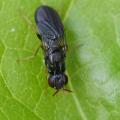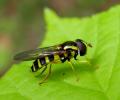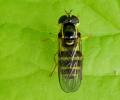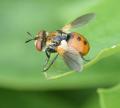|
which order? 2015-07-04, N. Germany > Psocomorpha
|
|
| Lennart Bendixen |
Posted on 05-12-2015 21:00
|
|
Member Location: Posts: 1171 Joined: 19.12.14 |
Hello, this insect is a mystery to me. I'd say it's a kind of Psocoptera, but with such a short abdomen? I hope someone here can help me. Lennart 2015-07-04, Northern Germany, S-H, Mohrkirch, house wall. Length about 1,5 mm. Edited by Lennart Bendixen on 06-12-2015 20:14 |
|
|
|
| Lennart Bendixen |
Posted on 05-12-2015 21:00
|
|
Member Location: Posts: 1171 Joined: 19.12.14 |
here's another picture |
|
|
|
| John Carr |
Posted on 06-12-2015 00:11
|
|
Member Location: Posts: 9773 Joined: 22.10.10 |
The antennae are wrong for Psocoptera. Maybe Sternorrhyncha? |
|
|
|
| Lennart Bendixen |
Posted on 06-12-2015 09:43
|
|
Member Location: Posts: 1171 Joined: 19.12.14 |
I have no experience with Sternorrhyncha, but this would really surprise me. But in fact, every order would surprise me ;-) Edit: Good hint, I think - could it be a Psyllidae nymph? Edited by Lennart Bendixen on 06-12-2015 10:21 |
|
|
|
| Sundew |
Posted on 06-12-2015 19:27
|
|
Member Location: Posts: 3890 Joined: 28.07.07 |
Psyllidae nymphs look different. To me, this is a typical barklouse face, and I'd even say, the face of an adult. The antenna has 13 segments, so suborder Psocomorpha. The antenna of this group is described as follows: "The antenna of Psocomorpha comprises a short scape, short pedicel, and eleven long flagellomeres. Lengths of flagellomeres are progressively shorter distally. Flagellomeres are clothed densely with long setae..." That fits well. However, something happened during the development of this animal. The thorax looks OK, but wings and abdomen not. I am familiarizing myself with the Psocids, becoming a true fan of them, but I have not seen such a misshaped individual up to now. May be it can survive nevertheless. Regards, Sundew |
|
|
|
| Lennart Bendixen |
Posted on 06-12-2015 20:13
|
|
Member Location: Posts: 1171 Joined: 19.12.14 |
Thanks a lot for your detailed and plausible answer. Now I miss some better pictures of it...but at that time I didn't think of something exceptional. You say you're getting familiar to this group, so if you should meet a specimen like this one day or read about, maybe you can tell us here. I'm really interested in how this can happen - and especially if this is known from a specific family. Greetings, Lennart |
|
|
|
| Paul Beuk |
Posted on 07-12-2015 08:31
|
|
Super Administrator Location: Posts: 19208 Joined: 11.05.04 |
Psocoptera, indeed. I guess the last moult went sour and the body and wings could not properly inflate.
Paul - - - - Paul Beuk on https://diptera.info |
|
|
|
| Sundew |
Posted on 07-12-2015 12:40
|
|
Member Location: Posts: 3890 Joined: 28.07.07 |
You could contact Psocid expert Keith Alexander (https://www.brc.a...rding.aspx) - he might have seen something similar. |
|
|
|
| Lennart Bendixen |
Posted on 07-12-2015 19:04
|
|
Member Location: Posts: 1171 Joined: 19.12.14 |
Thank you both for your answers; I'll report if he's got something more to say about it. |
|
|
|
| Jump to Forum: |














 but don't see the image in the post.
but don't see the image in the post.
